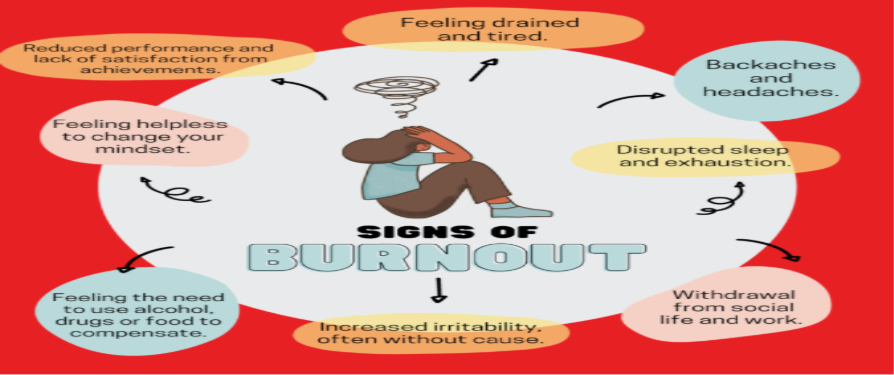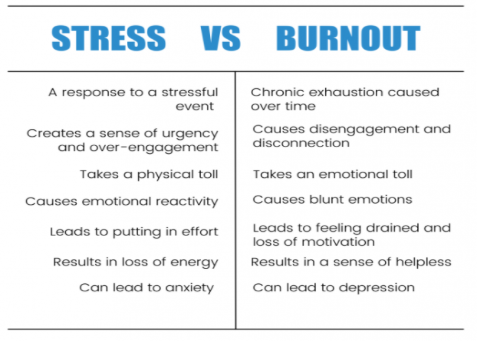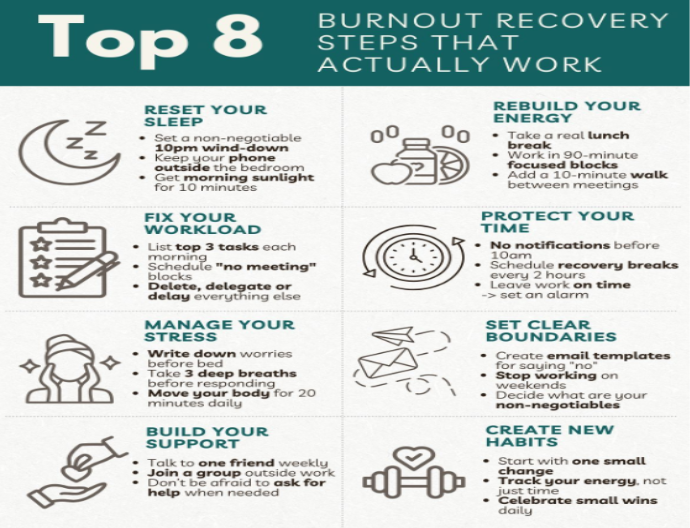Work Related Concerns
Employee Burnout in India: Signs, Causes, Recovery & Prevention Strategies

.png)
Written by
Aarohi Parakh,
Psychologist and Content Writer

Reviewed by
Sanjana Sivaram,
Psychologist and Clinical Content Head

Introduction
Picture this! Arjun, a software developer in Bengaluru, and Meera, a sales professional in Mumbai, often feel exhausted, emotionally drained, and unable to focus after long workdays. Add tight deadlines, family responsibilities, and long daily commutes, and it’s easy to see why many professionals experience burnout in Indian workplaces. (A 2024 SHRM study found that 44% of employees report feeling burnt out, with key causes including extended work hours and limited work-life balance.)
In India, burnout is becoming increasingly common across high-pressure workplaces—from tech start-ups and corporate offices to healthcare facilities. Recognising early signs and applying practical recovery and prevention strategies is essential for maintaining health, productivity, and a balanced work-life experience.
What is Burnout?
Burnout is emotional, mental, and often physical exhaustion brought on by prolonged or repeated stress. It develops when work demands exceed available resources and support. While commonly discussed in workplace contexts, burnout can also arise alongside other life pressures, such as being a caregiver, parent, or living with chronic illness.
The World Health Organization (WHO) defines burnout as an occupational phenomenon, not a medical condition, emphasising that it stems from workplace stress rather than an individual disorder. However, burnout can affect both physical and mental health, if left unacknowledged or unaddressed in a timely manner.
Burnout typically manifests across three core dimensions:
- Emotional Exhaustion – Feeling drained and unable to meet constant demands.
- Cynicism or Detachment – Developing a hostile, indifferent, or disengaged attitude towards work.
- Reduced Professional Efficacy – Experiencing a decline in performance, productivity, and confidence.
Why is it Important: Far-Reaching Impact
Burnout in Indian workplaces isn’t just an individual’s personal struggle — it ripples through companies, affecting workers and impacting productivity at the level of the overall economy as well. According to the Mayo Clinic, chronic burnout contributes to mental health deterioration, reduced life and job satisfaction, and rising conflict in personal and professional relationships. The NCBI study highlights the pervasive nature of burnout across different professions, especially those that are chronically exposed to work overload and intense work-related stress (healthcare professionals, police personnel, and other helping professionals).
The financial toll is real. A People Matters (2024) report estimated that burnout costs Indian companies ₹3.3 lakh to ₹17.4 lakh per employee annually due to absenteeism, disengagement, and productivity loss. Burnout costs businesses 2.9 times more than health insurance premiums, making it one of the most expensive hidden drains on corporate India. The business cost is steep—burnout and stress-related issues are estimated to cost Indian companies up to $350 billion annually (MHI, 2023).
The spillover effects extend beyond work: chronic fatigue, digestive issues, cardiovascular risk, headaches, and cognitive impairment often require long-term care. Burnout also strains personal relationships by increasing irritability, withdrawal, and disconnection from family and friends. This spiral feeds deeper unhappiness at work while pushing more people to quit. In India’s fast-paced sectors—technology, healthcare, and corporate services—long hours, high workloads, and pressure to perform amplify this harm, turning burnout into both a health struggle and a company cost.
Recognising Early Warning Signs
One part of burnout people rarely pay attention to? How quietly it sneaks up on you. It doesn’t appear overnight and evolves gradually with time. Recognising early signs means you’re more likely to step in before things get worse. Below are the common signs and symptoms, along with their typical progression over time, from early warning to more advanced stages.
Early / Primary Symptoms
These are the first red flags—things that many people brush aside as “just stress” or “a bad week,” but that persist and worsen over time:
1. Chronic Fatigue: An ongoing feeling of weariness that doesn't go away with rest. People may experience physical exhaustion or struggle to think clearly, even after getting a full night's sleep.
2. Concentration Issues: Inability to focus, forgetfulness, or constant distraction. Making decisions seems more difficult, and crucial information frequently gets lost.
3. Sleep Disturbances: There are two ways that burnout can interfere with sleep: either hypersomnia (sleeping too much but never feeling refreshed) or insomnia (difficulty falling or staying asleep, waking up restless or irritable).
4. Mood Swings and Irritability: Heightened impatience, emotional instability, or outbursts at small irritations. Previously manageable situations feel overwhelming.
5. Emotional Detachment: Feeling of detachment, numbness, or indifference. Individuals may become emotionally detached from their loved ones, coworkers, or even their own objectives, operating automatically rather than actively.
Advanced Indicators
Burnout frequently worsens if the early warning signs are disregarded, resulting in more severe psychological distress and physical symptoms. These more serious indicators signal that recovery is much harder without intervention:
1. Chronic Cynicism / Negative Attitude: Marked by persistent negativity, disillusionment, and emotional detachment from work or people. People may feel disillusioned with their duties or ask themselves, "What's the point?"
2. Inefficacy / Feelings of Reduced Accomplishment: Despite acknowledgement, people may feel that their efforts are insignificant.
3. Physical Ailments: The body's reaction to ongoing stress can manifest as unexplained aches and pains, such as headaches, tense muscles, or digestive problems, in employees.
4. Frequent Health Issues / Weak Immunity: Characterised by compromised immunity and slower recovery from minor sicknesses.
5. Persistent Sleep Disturbances: Chronic insomnia or hypersomnia with ongoing fatigue.

Why These Signs Matter
It is essential to note that these symptoms are not isolated—they tend to reinforce one another. For example, poor sleep worsens concentration, fatigue increases irritability, and emotional detachment deepens cynicism, among other effects.
In India, where “hustle culture” and “I am fine” attitudes are common, people often ignore these signals until the body forces a pause. Recognising the difference between everyday stress (such as pre-festival workload in retail) and burnout (a sustained state of depletion and detachment) is crucial.
Recovery can start more quickly if these warning signs are addressed early on—by modifying one's lifestyle, consulting with managers, or seeking professional help. Ignoring them not only lowers systemic productivity but also harms individuals.
Causes and Risk Factors
Burnout arises from an interplay of workplace demands, personal pressures, and individual traits. According to the World Health Organization (WHO) and extensive burnout research studies, key contributors include:
- Work Overload: Excessive tasks, long hours, and tight deadlines, common in Indian sectors like tech start-ups, healthcare, corporate, and education, increase exhaustion.
- Lack of Control and Autonomy: Limited autonomy and rigid hierarchies leave employees feeling powerless.
- Poor Rewards and Recognition: A mismatch between effort and acknowledgment—whether through compensation, promotions, or informal recognition—can reduce motivation and engagement.
- Insufficient Community and Support: When colleagues, supervisors, or teams fail to provide guidance or emotional backing, employees can feel isolated. In Indian workplaces, hierarchical divides and competition can exacerbate this lack of community.
- Value Conflicts and Perceived Unfairness: When what you personally value doesn't align with what the organisation stands for, or when things feel unfair, it can lead to being disconnected from one’s work.
- Mismatch Between Worker and Job: A poor alignment between a person’s skills, interests, or capacities and their responsibilities often leads to frustration and disengagement. For instance, a talented professional doing repetitive work may feel undervalued, while an overqualified employee burdened with menial tasks may experience dissatisfaction and stress.
- Lifestyle and Personal Factors: Excessive caregiving, poor work-life balance, lack of rest, perfectionism, and constant strive to succeed can increase vulnerability to burnout.
The high prevalence of burnout in India's high-pressure workplaces can be explained by the Job Demands–Resources (JD-R) framework. According to the model, burnout occurs when job demands (such as a high workload, mental strain, and emotional strain) consistently exceed the available resources (such as support, feedback, autonomy, and equitable recognition). This is supported by research using the Oldenburg Burnout Inventory (OLBI), which shows that a lack of resources causes disengagement and exhaustion, which is linked to high demands.
In Indian workplaces, this imbalance is particularly stark, making proactive organisational measures essential.
Prevention Strategies & Recovery
Although it may seem overwhelming, research indicates that when people and organisations take proactive measures, burnout can be avoided and even reversed. The most successful approaches incorporate both structural workplace interventions and self-care practices, according to the Mayo Clinic, WebMD, HelpGuide, and Mental Health UK.
Individual-Level Strategies:
- Make Self-Care a Priority: Recovering from burnout requires regular exercise, a healthy diet, and adequate sleep. Mind-body practices, such as Yoga and Pranayama, widely practised in India, have been proven to lower stress levels and improve resilience. It is essential to note that self-care is not merely occasional relaxation; it’s a daily discipline that requires conscious effort and consistency.
- Set Boundaries: Learning to say no, limiting overtime, and practising digital detoxes (e.g., logging off work emails after hours) help protect mental energy and prevent chronic stress.
- Take Breaks and Micro-Restorations: Short walks, breathing exercises, or mindfulness rituals during the day allow the nervous system to reset. The Mayo Clinic highlights scheduled downtime as a critical step in preventing burnout.
- Seek Support: Emotional connection is a buffer against burnout. Talking with friends, family, or colleagues can help reduce feelings of isolation. For professional help, counselling services, or Employee Assistance Programmes (EAPs), such as 1to1help, provide structured support for recovery.
- Mindfulness and Stress Management: Meditation, journaling, or gratitude practices—recommended by Psychology Today—build resilience and help individuals manage emotional exhaustion.
Organisational-Level Strategies:
- Balance Workloads and Expectations: In Indian workplaces, unrealistic deadlines, continuous overtime, and an "always-on" culture are the main causes of burnout. Organisations can mitigate this by establishing reasonable objectives, allocating responsibilities equitably, and allowing downtime in between projects with high demand.
- Improved Communication and Managerial Support: Clear communication between managers and staff fosters psychological safety and lessens ambiguity. Promoting frequent check-ins, candid criticism, and group decision-making makes workers feel appreciated and supported.
- Recognition and Fair Rewards: Burnout is strongly predicted by a lack of recognition. Retention is increased and disengagement is decreased through prompt appreciation, equitable compensation, and open promotion procedures.
- Workplace Wellness Programmes: Stress management workshops, mindfulness sessions, Cognitive Behavioural Therapy (CBT)-based training, rest breaks, and flexible schedules are effective secondary strategies. These programmes not only aid in recovery but also equip employees with long-term coping skills.
- Build Supportive Workplace Culture: Community and belonging are powerful protective factors. Companies can establish mentorship programmes, peer-support groups, and team-bonding initiatives to reduce isolation. A culture of trust and compassion lowers stress and builds resilience across teams.
Why Prevention Matters in Indian Workplaces
Burnout in India’s fast-moving sectors is more than personal fatigue—it quietly impacts engagement, collaboration, and results. Recognising the signs and applying simple, practical steps can safeguard both well-being and workplace performance
While corporate giants and large MNCs have taken steps to integrate wellness programmes and include hybrid work policies, the larger Indian workplace landscape still has a long way to go. For most organisations, preventive mental health practices remain underdeveloped, making it crucial to embed them across industries—not just at the top tier.
Practical Steps for Indian Context
Let us recall our stories of Arjun and Meera. Juggling between high demands at work, long commutes, and family responsibilities, they are already experiencing burnout.
Now, let’s paint a picture of how their recovery plan would look.
Arjun begins breaking large projects into smaller milestones, for instance, dividing a month-long coding sprint into weekly targets. This allows him to celebrate small wins and track progress without feeling overwhelmed. He also sets boundaries around late-night emails, reserving the last hour of his day for personal time, which gives him space to unwind and recharge.
Meanwhile, Meera, navigating a hierarchical sales team, practises open empathy by honestly sharing her feelings while considering her manager’s perspective. She says, “I’m feeling overwhelmed and need to realign priorities so I can contribute effectively. Can we discuss what’s most urgent?” This approach maintains respect, encourages clarity, and fosters a supportive work culture. Both Arjun and Meera incorporate micro-breaks and structured downtime into their days—such as short walks, digital detox periods, or a few minutes of mindful breathing—to recharge mentally and physically. They also lean on peer-support networks, sharing feedback, collaborating on projects, and seeking advice when facing challenging tasks.
As Arjun and Meera start applying these practical burnout prevention and recovery strategies, they begin to regain energy, focus, and a sense of control—showing that even in India’s high-pressure workplaces, small, intentional actions can help employees thrive rather than survive.

FAQs
Q1. Is burnout a disease or simply a form of stress?
Burnout is not classified as a medical disease. According to the World Health Organization (WHO), it is an occupational phenomenon resulting from chronic workplace stress that has not been managed effectively.
While stress arises from external pressures demanding too much physically and mentally, burnout reflects prolonged depletion and emotional exhaustion. Stressed individuals often feel relief is possible by regaining control, whereas those experiencing burnout feel detached, unmotivated, and overwhelmed, with little energy or hope to cope. While all three dimensions of health (physical, mental, emotional) are impacted in both cases, stress primarily manifests in the form of physical toll, whereas burnout in the form of mental and emotional toll.

Q2. How is burnout different from depression?
Burnout and depression can be difficult to differentiate, as both conditions share symptoms such as fatigue, difficulty concentrating, and low motivation. Burnout, however, is often situation-specific and linked to prolonged demands, whereas depression is a clinical mood disorder that can affect all areas of life, not just work or caregiving responsibilities. Moreover, burnout can act as a risk factor for depression if left unaddressed.

Q3. What immediate steps can I take when I'm feeling burnt out?
- Take micro-breaks during work and incorporate short walks, mindfulness, or relaxation exercises.
- Prioritise sleep, nutrition, and hydration to restore energy.
- Set realistic work goals and break larger projects into smaller milestones.
- Communicate openly with managers or colleagues about workload and support needs.
- Seek social or professional support, including Employee Assistance Programmes (EAPs) or counselling services (e.g. from 1to1help).
Q4. How can managers in India prevent burnout in teams?
- Encourage open communication about workload and stress without judgment.
- Promote work-life balance with flexible schedules or realistic deadlines.
- Recognise and reward employee contributions to maintain motivation.
- Provide access to wellness resources such as stress management workshops, mindfulness sessions, or counselling services/EAPs.
- Foster a supportive work culture where employees feel valued, heard, and psychologically safe.
Q5. When should I seek professional help?
Seek professional guidance if you experience burnout symptoms:
- Last for weeks despite self-care efforts
- Impact on everyday functioning, concentration, or decision-making
- Causes extreme emotional distress or physical complaints
- Seek guidance from a mental health professional or counsellor to develop a structured recovery plan to lower the likelihood of deterioration into depression or long-term health problems.
Resources & Further Reading
Reference Links:
- Burnout HQ. The Hidden Epidemic: Understanding Burnout’s Devastating Impact and How to Prevent It. Link
- Cleveland Clinic. Chronic Illness: Sources of Stress, How to Cope. Link
- HelpGuide. Burnout Prevention and Recovery. Link
- Mayo Clinic. Breaking Down Burnout in the Workplace. Link
- Mayo Clinic. Burnout: Symptoms and Prevention. Link
- Mental Health UK. Burnout: Understanding the Impact on Mental Health. Link
- PMC (National Center for Biotechnology Information). Burnout in the Workplace: A Review. Link
- People Matters. Burnout Costs Businesses 2.9x More Than Health Insurance: Report. Link
- Psychology Today. Burnout Basics. Link
- Psychology Today. Stress Basics. Link
- The Live Love Laugh Foundation. Workplace Burnout in India: Signs, Solutions & Leadership. Link
- WebMD. Signs of Burnout. Link
- WebMD. Burnout Symptoms, Signs, Causes & Treatment. WebMD. Link
- What's the Difference between Burnout and Depression? - https://healthnewsday.com/whats-difference-burnout-depression/Wikipedia. Occupational Burnout. Link
- World Health Organization (WHO). Burn-out an “Occupational Phenomenon”: International Classification of Diseases. 28 May 2019. Link
Reach out to 1to1help at 📞 1800 258 8999 / 1800 258 8121 if you are looking for counselling support, Employee Assistance Programme (EAP) resources, or workshops on wellness and stress management.
Burnout Self-Assessment Checklist
Disclaimer: This checklist can be used for personal reflection on burnout symptoms and is not a diagnostic tool. For concerns about burnout or mental health, consult a qualified mental health professional.
Burnout Recovery Plan
https://www.choosingtherapy.com/therapy-worksheets/burnout-recovery-plan/











